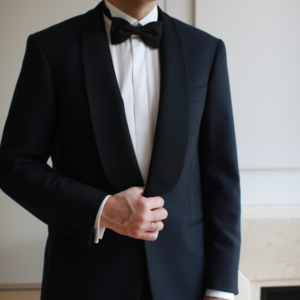How To Wear a Tuxedo in 2023: Lapels, Fabric, Colour, Accessories, and Cut
A tuxedo is a classic elegant garment. Gentlemen appear effortlessly sharp when wearing a tux. Let's discuss the various style intricacies of this garment.

While one choice (such as black or midnight blue) is not better than another, each can subtly change the tone of the tuxedo.
This is a comprehensive guide to the questions we are most frequently asked at Artefact London as we guide our customers when making bespoke tuxedos.
Our expert guidance will lead you through each decision you’ll face when buying the perfect tuxedo. As you choose between a single- breasted and a double- breasted tuxedo, or between shawl and peak lapels, you’ll have all the knowledge you need to make the best decision for you.
We will discuss:
Dinner Suit vs Tuxedo? What is the Difference?
A tuxedo and a dinner suit are two terms used interchangeably. They refer to a formal, tailored suit with lapels made in satin which is worn to black- tie events. Referring to a formal suit as a ‘dinner suit’ or a ‘tuxedo’ is accurate, they both adhere to the same characteristics on fabric, colour, lapels, and accessories.
Is Dinner Jacket same as Dinner Suit?
A dinner suit/ tuxedo has jacket & trousers made of matching cloth: black or midnight blue.
A dinner jacket whilst still a formal garment is made of colourful fabrics: think burgundy, bottle green velvets, jacquards fabrics with motif etc.
Mohair Tuxedo Vs Wool Tuxedo - what is the difference?
Tuxedos can be made from a number of fabrics. The cheaper the tuxedo, the more polyester it will contain. This shiny, plastic- feeling fabric should be avoided at all costs. Synthetic fabrics are shiny and garish.
The best options are natural fibres such as wool or mohair, as they are breathable and comfortable for the wearer.
Mohair is a strong, coarse fibre from the Angora goat. It gives the tuxedo a crisp finish.
Wool an excellent natural fibre is a softer fibre than mohair. Wool can also have different specifications. For example S130s will be softer and have more sheen than Wool S100s specification.
Years of fine tuning has found the best blend for tuxedo fabric is a combination of wool and mohair. This blend of fabric is lightweight and crease resistant. The matte finish of mohair, and the softness and of wool make this cloth perfect for a tuxedo.
Shawl vs Peak Lapel Tuxedo?
Both options are timeless classics. In choosing which lapel works best for you, be guided by your body shape.

Shawl Lapel
A shawl lapel describes how the lapel drapes around the jacket, like a shawl or scarf. It sweeps across the jacket of the tuxedo. Around the chest and collar the lapel is at its widest and it tapers to stop at the button at the front of the jacket.
The shape of the shawl lapel contrasts with the strong triangular shape of the body in a tailored tuxedo. It draws the eye to the chest and elongates your shape making the wearer appear taller.
Peak Lapel
The peak lapel is named because of the pointed, sharp “peaks” at the top part of the lapel. Like the shawl lapel, the peak lapel is made of silk. It tapers to a narrow point at the button fastening of the jacket, highlighting the angular nature of the lapel.
The peak lapel makes your shoulders look broader. The widest points of the lapel accentuate the width of your shoulders, echoing the classic triangular tuxedo shape. If you’re hoping to visually create a narrower waist line and a draw attention up to the shoulder, the peak lapel is best for you.
Can Tuxedos Have Notch Lapels?

Notch lapels are usually found on business suit jackets or casual blazers, something you would wear for the office or for a smart casual event.
Tuxedos are not traditionally made with notch lapels, although some trendy designers try to popularise this look look making a tuxedo appear more casual. However, a purpose of a tuxedo is not to look casual. Our advice is to steer clear of any tuxedos made with a notch lapel.
Should you wear a black tuxedo or a navy tuxedo?
There are two classic choices for a tuxedo: midnight blue or black. The difference between the two is very subtle. When someone refers to a tuxedo as navy, the colour they are most likely referring to is midnight blue. Midnight blue is darker than navy and is close to black.
A navy colour is too light a shade for a tuxedo. See image below comparing the colours.
So which one is right for you - midnight blue or black?
-

Midnight Blue Navy Tuxedo Dinner Suit
£1,200 Select options This product has multiple variants. The options may be chosen on the product page -

Peak Lapel Tuxedo
£1,200 Select options This product has multiple variants. The options may be chosen on the product page
Black Dinner Suit
Midnight Blue (Navy) Tuxedo
A midnight blue tuxedo is often considered more contemporary than a black tuxedo. While the colours appear similar, it is the way the colours are affected by light which is different. In artificial light, midnight blue looks blacker than black. Wearing a black tuxedo in artificial light can inadvertently show a greenish or charcoal tone to the fabric, whereas midnight blue gives a deep tone of black.
Black Tuxedo Colour
The ultimate classic, a black tuxedo is refined, and timeless. Black is the first option most people think of when hearing “black- tie” and it has been made famous all over the world by celebrities and icons such as James Bond. A black tuxedo is perfect for daytime events such as weddings, and any summer events when the natural light lingers late into the evening.
Although, strictly speaking, a tuxedo should only be worn after dark or from 5pm onwards. It is becoming increasingly common to have daytime events with a black-tie dress code.
Double-Breasted Tuxedo vs Single- Breasted Tuxedo

The Single-Breasted Tuxedo Jacket
Most tuxedos are single- breasted giving the iconic V shape to the jacket. Having one button to close the jacket means the lapels of the jacket form a lower ‘V’ shape than if the jacket had two button rows.
The single- breasted version of the tuxedo is as formal as the double- breasted version, but the former can be worn unbuttoned. Unbuttoning the jacket can be acceptable towards the end of the evening as things get going on the dance floor, but does lend itself to a marginally more casual look. Having an open jacket exposes the wearer’s waistcoat or cummerbund. If you are not wearing a cummerbund or waistcoat, we would suggest keeping the jacket buttoned up throughout the evening.
The Double- Breasted Tuxedo Jacket
An alternative to the single- breasted tuxedo is the double- breasted tuxedo, which has a slightly more formal feel to it. Having two sets of buttons gives more structure and sturdiness to the jacket, and generally more support to the waist area. The buttoning on a double-breasted tuxedo is higher with less of the shirt visible. As the jacket should remain buttoned up, the cummerbund or waistcoat aren’t worn. The overall look is one that is a fraction more formal, literally more “buttoned up”. Read more about double-breasted suits here.
FAQs: Tuxedo Accessories to Complete the Look
There are straightforward and clear rules on accessories to go with your tuxedo. The overall rule is keeping it simple and understated. This is what Black-Tie for gentlemen is about.
Do I need to wear a dress shirt?

When wearing a tuxedo, you must wear a dress shirt.
Dress shirts are longer than a shirt you’d wear to the office or in a casual setting. A longer shirt allows for dancing and more movement without the risk of the shirt becoming untucked and the gentleman appearing dishevelled.
The collar of a dress shirt is short tipped allowing room for a bow tie to sit comfortably at the neck. Additionally, dress shirts do not have buttons. Studs are used instead - small metal accessories which hold two pieces of fabric together, in this case the front, or cuffs of a shirt.
A dress shirt always has French cuffs and is worn with cufflinks.
A very traditional dress shirt has a marcello front or pleats at the front. Recently it has became common to have a plain fronted dress shirts.
Do I need to wear cufflinks with tuxedo?
A dress shirt must be worn with your tux and those
always have French cuffs hence need cufflinks. These should be understated, simple, and match whatever other metal you are wearing.
If your watch and wedding ring are silver, having silver cufflinks will show attention to detail. You can take this one step further by matching the studs of your dress shirt and your cufflinks. A set of silver cufflinks and studs with mother- of- pearl, or black inlay will perfectly finish your outfit.
Do I need to wear a bow tie with the tuxedo?
A bow-tie is a must. Ideally, not be a pre-tied or a clip-on version. The bow tie must be tied snuggly around the collar and have the “quirks” of a hand- tied version, whereas a pre-tied accessory will look too “perfect”.
Should I wear a dress watch with my tuxedo?
Wearing a watch is not an essential tuxedo accessory. If you choose to wear one: it should be simple in design and barely noticeable. It will need to be slimmer to hide comfortably under the French cuffs. This type of watch is called a dress watch. The metal of your watch should ideally match your cufflinks, studs and wedding band.
Can I wear a colourful pocket square with a tuxedo?
It is best not to. Traditional black tie dress code for men is understated and classic. Plain white pocket squares are best. Folded in a neat square or add a touch of panache with a puff or a double puff fold.
Should I wear a waistcoat with a tuxedo?
Customarily, when wearing a tuxedo, the shirt between the gentleman’s trousers and the button of the jacket should not be seen. A waistcoat is worn to conceal where the shirt is tucked in, giving a streamlined, clean, silhouette.
It is increasingly common to break the traditional rule about wearing a waistcoat, with some gentlemen choosing not to wear a waistcoat at all. If the event you are attending has a slightly more relaxed tone, you can omit the waistcoat.
Should I wear a cummerbund with a tuxedo?
A cummerbund is a wide belt of satin fabric which conceals the waistband of the trousers where the shirt is tucked in.
If waistcoats are not your style, but you want to keep your tuxedo quite formal, then a cummerbund is a great option.
The cummerbund was invented as an alternative to a waistcoat so a gentleman could wear fewer layers of fabric and feel cooler. Cummerbunds are worn both in summer and winter.
Which shoes to wear with a tuxedo?
The traditional choice to go with your tuxedo are black patent shoes or dress shoes in other words. The shine of the shoe is echoed in the silk of the lapel, and of the cummerbund (if one is worn).
Black Oxford shoes can be worn instead if patent is not your style.
Need More Guidance on Dressing for Black Tie?
We hope above guidance was helpful in understanding the various tuxedo elements. If you would like Artefact London Bespoke tailoring to take care of your Black Tie outfit - get in touch! Or see our Limited Edition Made to Wear Tuxedos.
Want a Bespoke Tuxedo to Impress?
Get in Touch!
-

Midnight Blue Navy Tuxedo Dinner Suit
£1,200 Select options This product has multiple variants. The options may be chosen on the product page -

Peak Lapel Tuxedo
£1,200 Select options This product has multiple variants. The options may be chosen on the product page
Black Dinner Suit




